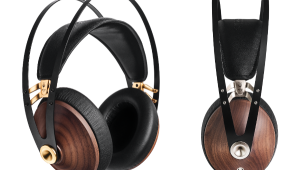Review: HiFiMan HE-6 Headphone and EF-6 Amplifier Page 2
Digging deeper into the HE-6
After Will and Lauren finished their listening, I settled in for some longer-term, in-depth listening — which ended up lasting for a couple of months as various hot new products pushed the HE-6/EF-6 combo further back in my review queue. No matter what I was listening to, though, it was always good to get back to the HiFiMan rig.
First let’s talk about the HE-6, which sounds every bit as good as Will and Lauren said it did. It’s probably most illuminating to compare it to the HE-500, which has been my reference headphone ever since we reviewed it. I’m often reluctant to proclaim one headphone superior to another, because different people seem to hear headphones differently, but good as the HE-500 is, the HE-6 is clearly superior. The HE-500 sounds neutral until you put on the HE-6, then the less-expensive model’s flaws become evident. (For this comparison, I drove both with my Rane HC-6 six-output professional headphone amp, which made quick swaps easy.)
To me, the biggest difference is in the midrange, which sounds considerably smoother in the HE-6. I noticed when listening to “Concerto for Cello and Orchestra, Movement 3” from David Chesky’s String Theory CD that the cello sounded much clearer and more vivid through the HE-6. I heard more of the friction and bite of the bow scraping against the strings, and the sound was smoother from note to note. In comparison, the HE-500 sounded like it had a bit of a dip in the midrange.
When I switched to “Alabama Lubijee” from the Crow Quill Night Owls’ Mechanical Unicorn, the group’s traditional instruments — National resonator guitar, calfskin-head banjo, washtub bass—had a lot more midrange bite and detail through the HE-6. I also noticed that the HE-500’s bass seemed to have more of a high-Q, underdamped, very slightly boomy sound — which was pretty amazing, because the HE-500 makes most other headphones’ bass sound underdamped and boomy. This recording also highlighted what I consider the HE-6’s only real flaw: the treble can be a tad edgy and overemphasized at times. It’s never harsh, just very present, and on probably 90 percent of all the music I heard through the HE-6, the treble sounded just perfect.
I’ve got the power
Well, at least I did when the HE-6 was plugged into the EF-6. Otherwise, I most definitely did not have the power needed to drive this hungry headphone.
I did most of my testing of the EF-6 by comparing it with my Musical Fidelity V-Can headphone amp, with levels matched to within about 0.2 dB and both units fed tunes from my computer via the Firestone Audio ILTW USB DAC. At $199, the V-Can costs just a fraction of the EF-6’s price, but it’s a well-regarded unit and I’m used to its sound.
I was surprised to find that the V-Can generally had enough power to drive the HE-6 to high volume with most material. However, certain cuts pushed the V-Can past its limits. One was “Calcutta Cutie” from the HDTracks 24/96 download of Horace Silver’s Song For My Father. The bridge of the tune gets pretty loud — too loud for the V-Can to handle with the HE-6. I heard quite a bit of distortion in the piano and trumpet. But all it took to get rid of the distortion was to yank the HE-6’s plug out of the V-Can and pop it into the EF-6. Same volume, same headphone, same tune, but the distortion disappeared.
When I was comparing the two, I was reminded of the comments of some of the not-so-experienced subjects I’ve occasionally drafted for listening panels. Often, when I ask why they like product B more than product A, they’ve simply said, “It just sounds better.” And that’s exactly what I thought when comparing these two amps. Their tonal balances were, to my ears, identical; neither emphasized any particular part of the audio range. Yet the EF-6 always sounded better.
As I listened to “One Meter Microphone Test” from Dr. Chesky’s Sensational, Fantastic, and Simply Amazing Binaural Sound Show (the best $15.98 any headphone fan could ever spend), I noticed that I heard a more realistic sense of ambience when David Chesky speaks into the binaural recording head from about 30 feet away. It seemed that I could hear more of the subtle echoes reverberating off the various features of the cathedral in which the recording was made.
As Chesky started to walk toward the binaural recording head, and his voice became more direct and less reverberant, I noticed also that it sounded smoother through the EF-6, with more detail and definition in the upper midrange, especially. Through the V-Can, it sounded comparatively dull and crude — still good, just not as good. Same with the guitar and chanted vocals in “Trembling Hands” from Explosions in the Sky’s Take Care, Take Care, Take Care. Without changing the overall tonality of the tune, the EF-6 simply seemed to find more information, more detail, more life in the midrange.






















































